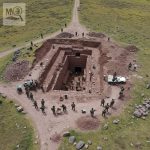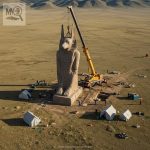Frozen in Time: 1,000-Year-Old Plane Discovered in Antarctica

In a discovery that has stunned the scientific community and captured the imagination of the public, explorers in Antarctica have uncovered a plane preserved in ice for over 1,000 years. Unlike any known aircraft, this remarkable find contains skeletal remains seated as if mid-flight, surrounded by unusual inscriptions and mechanical components that defy conventional understanding of ancient technology. The discovery raises profound questions about lost civilizations, advanced engineering, and possibly even extraterrestrial influence.
The Discovery

The plane was found buried deep within the Antarctic ice, its fuselage intact and remarkably well-preserved despite the passage of a millennium. The skeletal remains inside are positioned in a way that suggests they perished during operation, offering an eerie glimpse into the past. The surrounding mechanical components are unlike any technology known to historical civilizations, hinting at engineering sophistication far beyond what is currently documented.
Researchers are meticulously documenting the site, using advanced imaging, 3D modeling, and material analysis to understand the plane’s construction, functionality, and origins. Early observations reveal a combination of materials and designs that do not correspond to any conventional aircraft known in human history, fueling speculation and debate.
The Inscriptions and Anomalies
The plane is adorned with cryptic inscriptions etched into its surfaces, the meaning of which remains unknown. Scholars and linguists are studying the symbols to determine whether they represent a lost language, technical schematics, or symbolic communication. The precision of the engravings, combined with the advanced mechanical components, suggests a level of knowledge and craftsmanship that challenges current timelines of technological development.

Theories and Implications
The discovery has inspired a wide range of theories. Some scientists suggest the plane may be the product of a lost, technologically advanced civilization that existed long before previously recorded history. Others speculate that it could be evidence of experimental human engineering, perhaps a forgotten project preserved in extreme Antarctic conditions. More controversial interpretations propose extraterrestrial involvement, positing that the plane and its occupant may not be entirely terrestrial in origin.
Skeptics urge caution, noting that preservation in ice can create unusual optical and structural illusions, and anomalies in mechanical components might be misinterpreted. However, the combination of skeletal remains, complex machinery, and enigmatic inscriptions makes this find one of the most extraordinary archaeological and historical mysteries of modern times.
The Broader Significance
If validated, the Antarctic plane could radically reshape our understanding of history, technology, and human or non-human innovation. It challenges conventional timelines of aviation, engineering, and cultural development, suggesting that unknown forces or civilizations may have influenced our world in ways we are only beginning to grasp.
Conclusion
The 1,000-year-old plane frozen in Antarctica is a haunting and extraordinary enigma. With skeletal remains, advanced mechanical components, and mysterious inscriptions, it defies conventional understanding and blurs the line between history, science, and legend. As researchers continue their meticulous study, this frozen relic holds the potential to rewrite our understanding of ancient technology, exploration, and perhaps the very story of humanity itself. Antarctica, long a land of extremes, has revealed yet another secret, reminding us that the past may still hold mysteries beyond our imagination.










